How to identify the best ASX tech stocks (and two key picks)

Wilsons Advisory
Over the past decade, large cap Australian tech stocks have outperformed the broader ASX 200 index.
These stocks have a history of trading at high valuation multiples relative to the market, leading to the (sometimes incorrect) perception that they are prohibitively ‘expensive’ for investors. However, their past performance suggests their future earnings potential in many cases justifies these premium prices.
Ultimately, as Australian tech stocks can offer above-market returns, they remain an important part of our focus. However, after a strong run being selective is key.
Figure 1: The ASX 200 IT sector has outperformed the index over the last 10 years (with some volatility)
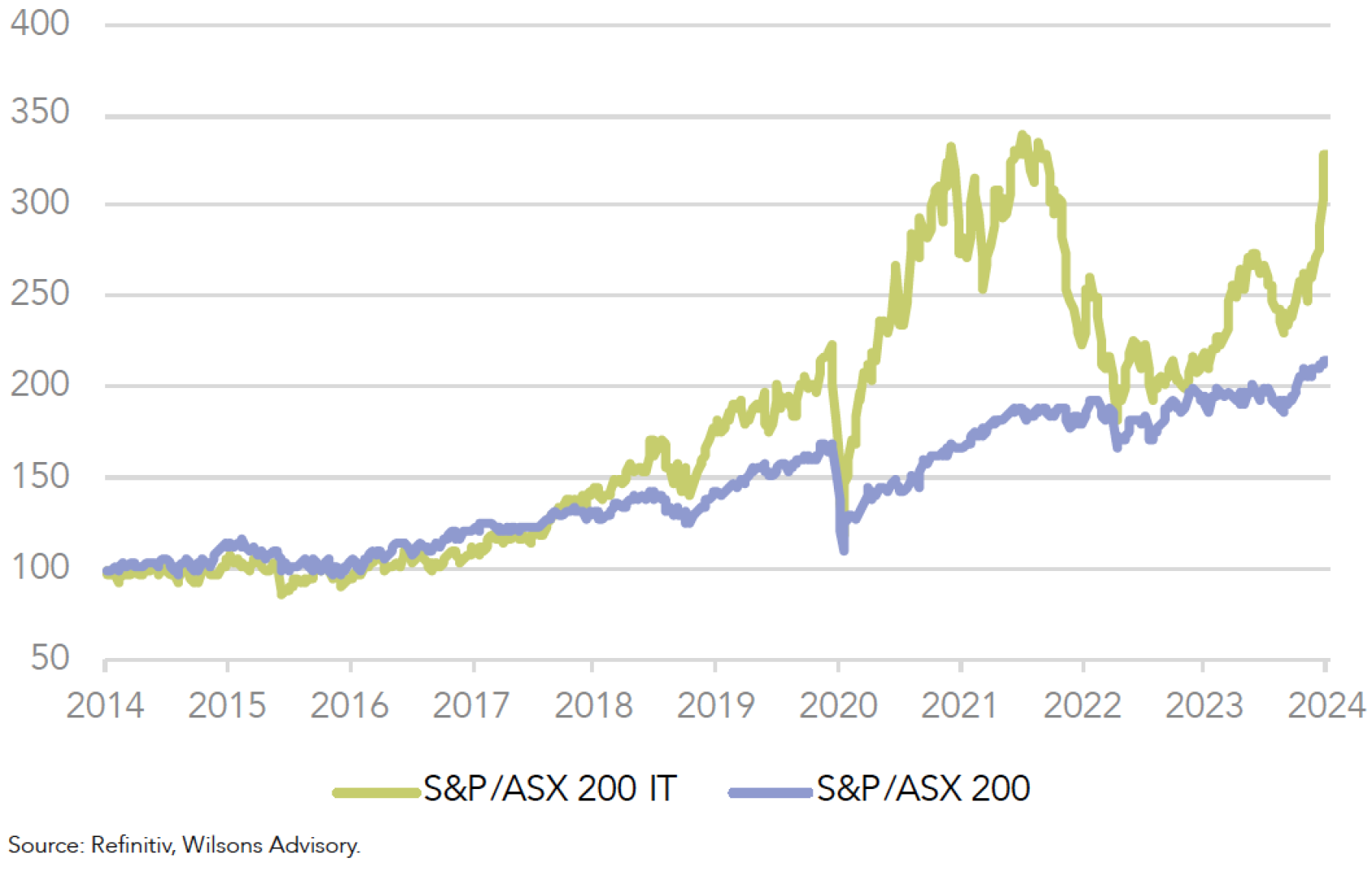
Drivers of outperformance
Australian tech stocks can offer compelling returns, typically driven by these 3 core factors:
High future earnings potential: Tech companies often benefit from wide economic moats (e.g. network effects, switching costs) and are exposed to strong structural tailwinds (e.g. digitalisation, cloud growth) which together can drive significant, above-market growth in earnings over medium and long-term, in some cases justifying a premium valuation multiple today.
Potential for analyst upgrades: Analysts have a tendency to underestimate (or be conservative when forecasting) the long-term earnings potential of structural growth companies within the tech sector, which can drive earnings/price target ‘upgrades’ over time.
Margin surprises: Cost-cutting efforts are often underestimated by the market and can unlock significant margin improvements, driving swift upward inflections in profitability, which can still be achieved while maintaining strong topline growth in some cases.
Figure 2: XRO derate has still coincided with strong returns, driven by strong earnings growth

Source: Refinitiv, Wilsons Advisory.
A case in point is Xero (ASX: XRO). Five years ago, XRO's forward 12-month PER stood at a lofty 200x. Today, this valuation has rebased to a more moderate (but still high) 83x. However, this PER compression has not hindered share price appreciation, which has grown from ~$50 to ~$130, representing an annualized return of ~21%. This divergence underscores the potential shortcomings of the PER as a solitary valuation tool. Xero's robust earnings growth, coupled with upward revisions to future earnings estimates (likely not fully priced in 5 years ago), has propelled the stock's upward trajectory.
Figure 3: XRO has seen significant earning revisions over the last 2 years

Source: Refinitiv, Wilsons Advisory.
Tech can continue to outperform
Strong earnings growth will in all likelihood be the main driver of continued outperformance in the sector. Additionally, potential rate cuts by the Fed later this year and the likelihood of lower bond yields could create a tailwind for growth-company valuations. These factors combined suggest tech stocks are well-placed to keep outperforming the broader market over the medium-term.
While some tech companies are becoming somewhat expensive relative to their earnings growth outlooks, there are still attractive opportunities at reasonable valuations that are well placed to outperform over the medium term.
The multifaceted approach to stock selection
Many investors get deterred by the high multiples tech stocks command. Relying on earnings multiples alone is unwise, which necessitates a more multifaceted approach when assessing tech company valuations.
The ASX 200 IT index only captures a portion of Australian tech. Many tech-driven companies reside in other sectors like media, consumer discretionary, financials, and real estate.
To identify the best ASX tech stocks:
Consider the stock's valuation relative to its longer-term growth potential. We can use the PEG ratio (price-to-earnings divided by 3-year earnings per share growth) to do this.
Evaluate how much future growth is already priced into the stock. A high PER in 3-5 years’ time suggests the market has already priced a lot of the growth.
Identify earnings upside surprise. Look for factors that could lead to the company increasing its earnings in excess of what analysts expect.
Financial Health. Look at other factors such as balance sheet, higher ROE and margins to ascertain the amount of profits that can be reinvested back into the business or used for acquisitions.
Figure 4: ASX tech screen. PEG offer a good starting place, but earnings quality, balance sheet and earnings upside are an important overlay.
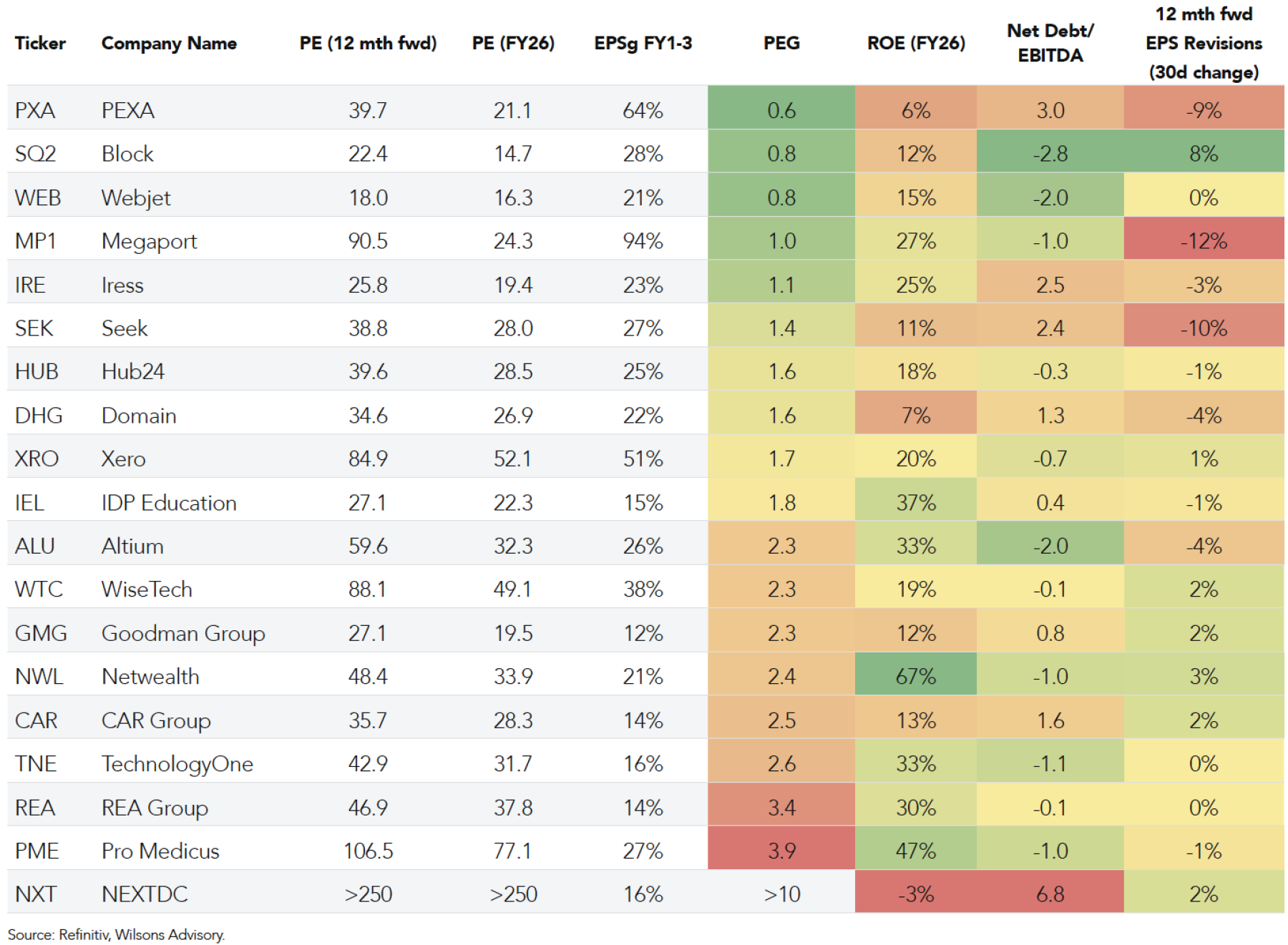
Our key picks: Xero - Inflecting financials present upgrade potential
Xero (XRO) is the dominant online accounting platform for SMEs in Australia / New Zealand (ANZ), and has a growing subscriber base offshore in the UK and the US. The company is one of the highest quality growth stocks on the ASX and remains an attractive investment opportunity at current levels.
Strategic pivot drives inflecting profitability
Over the last 12 months under new leadership, XRO has pivoted its focus towards better balancing its growth and profit objectives. In this vein, XRO has adopted the ‘rule of 40’ measure (defined as the sum of annual revenue growth percentage and free cash flow margin), which places a greater emphasis on its profitability.
Management aims to double revenues and achieve the rule of 40 ‘or greater’ long term. To achieve this aspiration, XRO has restructured its cost base with a ~15% workforce rationalization last year, and the business is on track to reduce its operating expenses (as a % of revenues) in FY24 to ~75%, down from ~81% in FY23 and ~84% in FY22.
As XRO builds more scale, there is still significant scope to wind back its high rate of investment into marketing and product development in-line with mature software businesses offshore (where total OPEX typically represents ~50% of revenues). Over time, as subscriber growth outpaces cost growth, XRO will benefit from widening operating jaws which will underpin significant improvements in its operating margin, earnings and ROIC.
Figure 5: XRO’s profit margins are expected to expand substantially
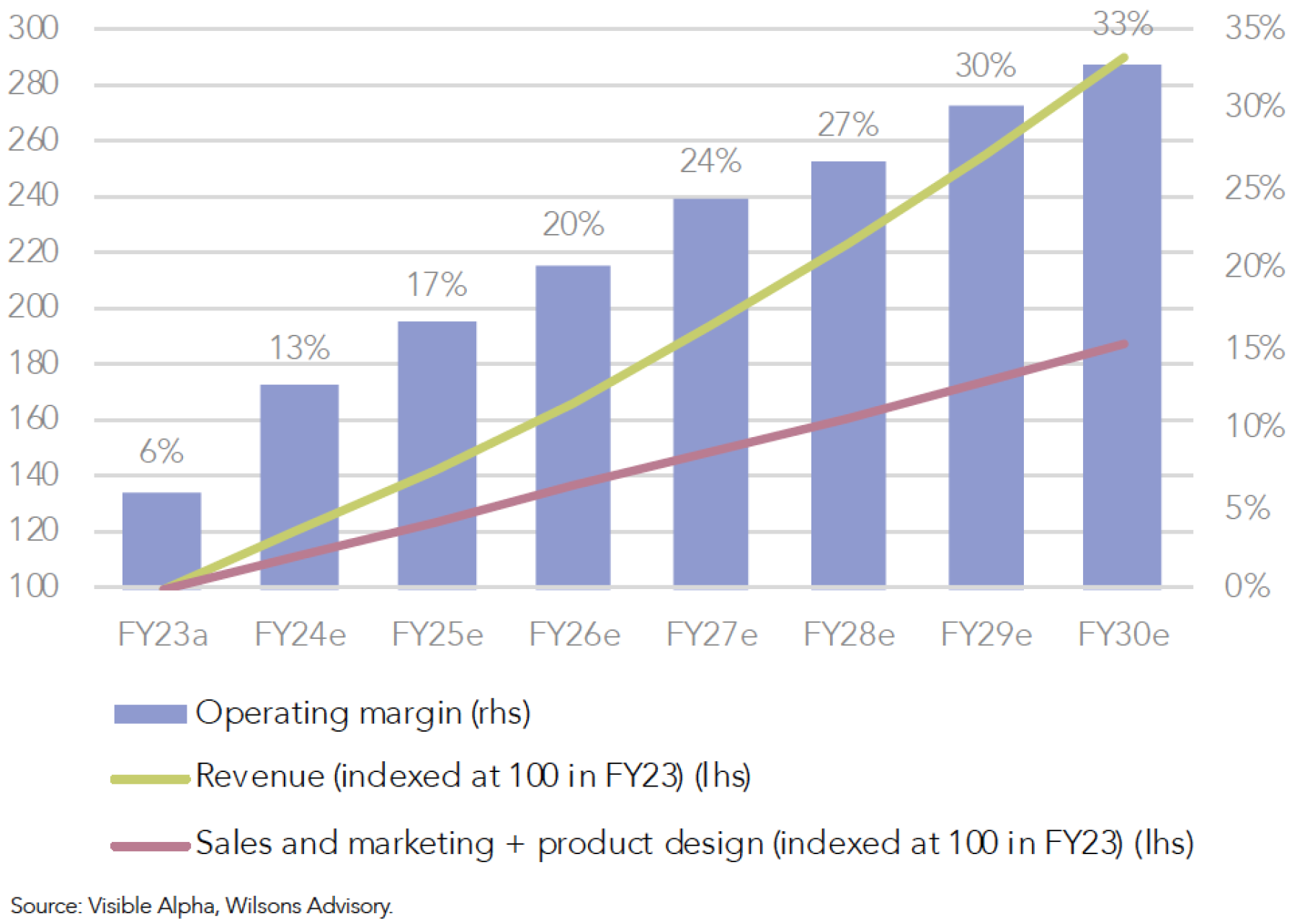
Substantial scope to further monetise subscriber base
There are numerous levers at XRO’s disposal to increase its ARPU (average revenue per user) and further monetise its large subscriber over the medium
to long-term. The main lever will be pricing, although there are also cross-sell/upsell opportunities available through improved product bundling as well as plan upgrades (to higher ARPU plans) which will be incentivized by the integration of GenAI functionality into its premium products. In terms of pricing, XRO is priced competitively compared to its peers, leaving it well placed to increase its plan prices over time to drive ARPU higher.
XRO's current ARPU is $22, half that of competitor Intuit's $42. In 3 years, Intuit grew its ARPU by 47% after reaching 4 million subscribers (XRO's current base). Analyst forecasts for XRO's ARPU growth (14% over 3 years) significantly underestimates this potential when compared to Intuit's success.
Figure 6: XRO has is a big opportunity to further monetise its subscriber base
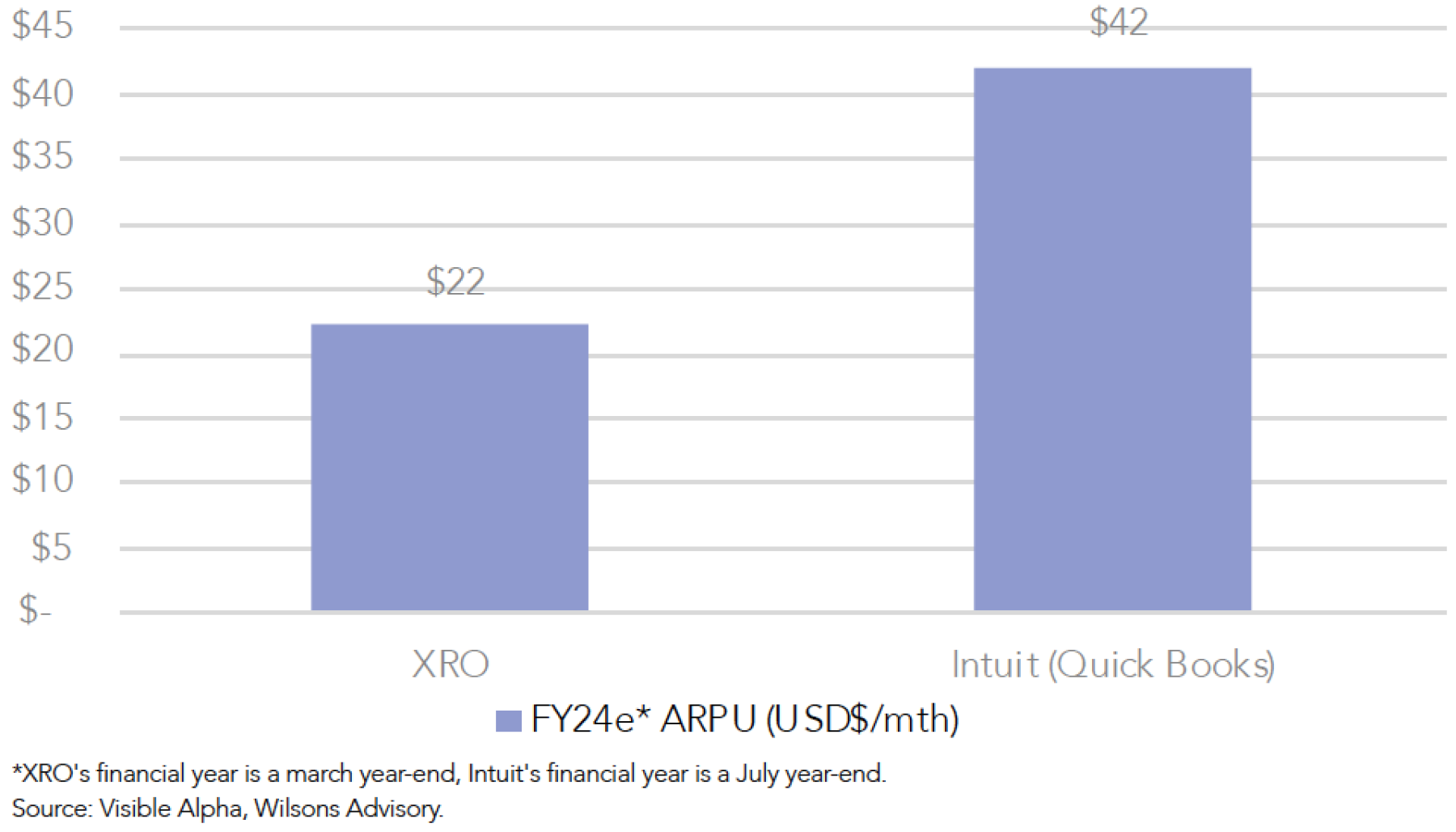
Cloud tailwinds to drive double-digit subscriber growth
XRO’s cloud-native product offering positions it to be a key beneficiary of the ongoing structural growth in the ‘cloud’ as businesses transition their IT systems from legacy ‘on-premise’ solutions towards the more flexible, cloud-based SaaS model. There remains a long runway for further growth long-term, considering XRO’s global TAM is estimated at ~45m, implying the company’s penetration globally is still at <10% given its total subscriber base of ~4m. XRO’s strong value proposition (simple interface, wide adoption amongst accountants, ability to drive cost savings) positions the company to drive further adoption and share gains over time and deliver double-digit subscriber growth to FY30.
Figure 7: Consensus forecasts are highly conservative on XRO's ARPU expansion potential vs Intuit's actual ARPU growth in the 3 years post reaching ~4m subscribers
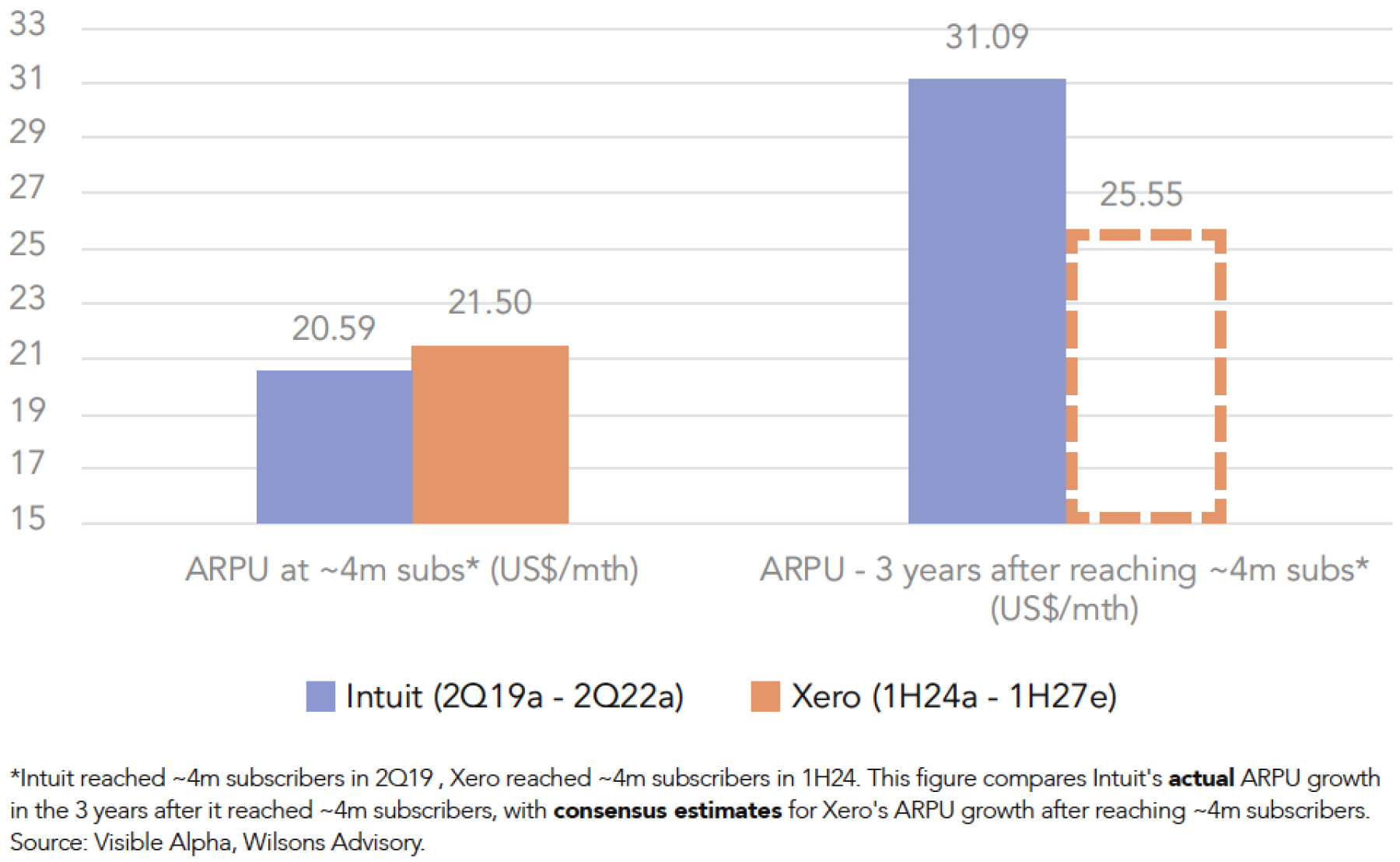
Netwealth – Structural tailwinds to drive strong earnings growth
Netwealth (ASX: NWL) is the largest specialist wealth management platform in Australia. The company is amongst the highest quality stocks on the ASX (given its top decile ROIC) and remains an attractive investment and core portfolio holding.
Plenty of room for specialty platforms to grow
Specialist platform providers (SPP) like NWL, Hub24 (ASX: HUB), and Praemium (ASX: PPS) have made significant market share gains over the last 5 years (led by NWL) with their collective market growing to ~17% as of December 2023, compared to ~4% in 2018. The structural trends supporting inflows towards SPPs (and outflows from incumbent platforms) remain strong and will continue to support FUA growth over the medium-term.
Post the Hayne banking Royal Commission, incumbent wealth management players (like AMP, BT, IFL, CFS) have been shedding advisers which have in large part moved to self-licensed and independent business models, resulting in outflows from their respective incumbent platforms and a migration of FUA towards specialty platforms. Moreover, incumbent platform consolidation/migrations (e.g. CFS, Insignia) have spun up opportunities for SPPs to gain share as advisers have ‘tested the market’ for alternative options.
Figure 8: Specialist platforms continue to take share from the incumbent players
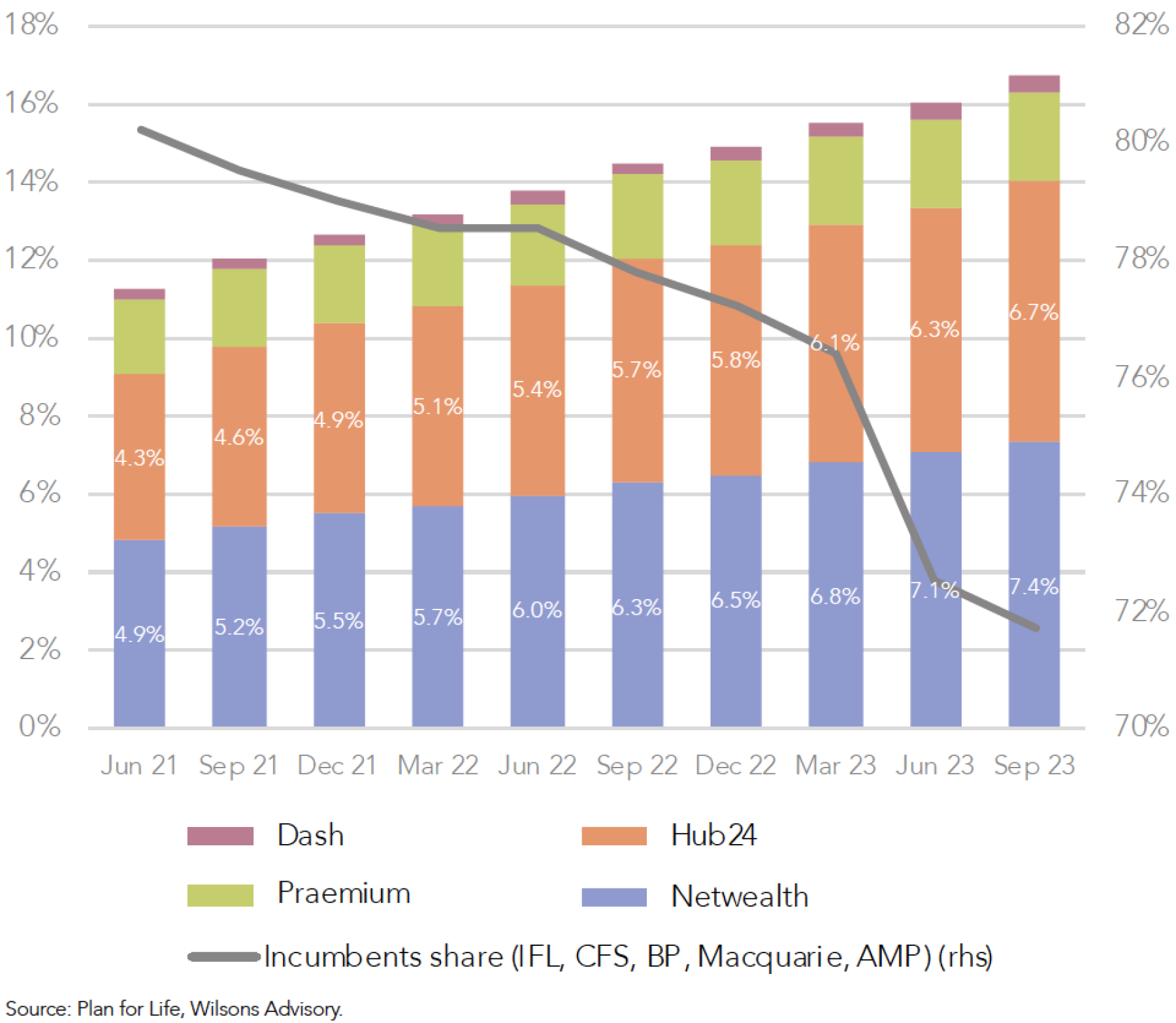
With incumbent platforms still holding >70% market share and the aforementioned structural trends still playing out, the runway for further gains remains significant for the SPPs. In this backdrop, NWL remains well placed to gain further inflows, which will underpin growth in its FUA, and therefore, its annuity-style platform fees.
High-quality model with significant margin expansion potential
NWL is the hallmark of quality on the ASX. As a capital light, tech-enabled business, NWL is amongst the most profitable businesses on the ASX, which underpins its exemplary ROIC of >100% (comfortably in the top decile of the ASX 200). As the business grows its funds under administration (FUA) from both market share gains and its inherent leverage to capital markets, NWL is positioned to further expand its margins and ROIC over time given its largely fixed cost base (i.e. its high degree of operating leverage).
Ultimately, NWL’s high ROIC will drive strong organic growth over the long-term as capital is reinvested into its product offering at a high rate of return (noting NWL is arguably years ahead of the incumbents when it comes to user experience and innovation). Another key appeal of the NWL model is its revenues are sticky and largely recurring/annuity-like in nature, which underpins a relatively high degree of earnings visibility for investors.
Learn more
Wilsons Advisory think differently and delves deeper to uncover a broad range of interesting investment opportunities for their clients. To read more of our latest research, visit our Research and Insights.
20 stocks mentioned

Expertise

